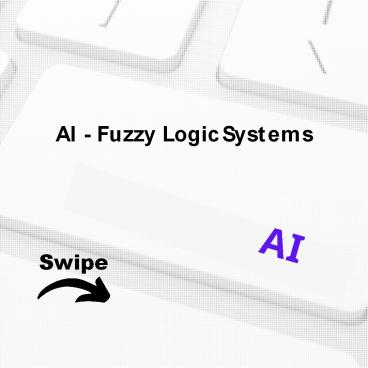AI - Fuzzy Logic Systems - PowerPoint PPT Presentation
Title:
AI - Fuzzy Logic Systems
Description:
This presentation educates you about AI - Fuzzy Logic Systems and its Implementation, Why Fuzzy Logic?, Why Fuzzy Logic?, Membership Function, Example of a Fuzzy Logic System and its Algorithm. For more topics stay tuned with Learnbay. – PowerPoint PPT presentation
Number of Views:132
Title: AI - Fuzzy Logic Systems
1
AI - Fuzzy Logic Systems
AI
Swipe
2
AI - Fuzzy Logic Systems
Fuzzy Logic Systems (FLS) produce acceptable but
definite output in response to incomplete, ambiguo
us, distorted, or inaccurate (fuzzy)
input. Fuzzy Logic (FL) is a method of reasoning
that resembles human reasoning. The approach of
FL imitates the way of decision making in humans
that involves all intermediate possibilities
between digital values YES and NO. The
conventional logic block that a computer can
understand takes precise input and produces a
definite output as TRUE or FALSE, which is
equivalent to humans YES or NO.
3
The inventor of fuzzy logic, Lotfi Zadeh,
observed that unlike computers, the human
decision making includes a range of possibilities
between YES and NO, such as- CERTAINLY YES
POSSIBLY YES CANNOT SAY POSSIBLY NO CERTAINLY
NO The fuzzy logic works on the levels of
possibilities of input to achieve the definite
output.
4
Implementation
It can be implemented in systems with various
sizes and capabilities ranging from small micro-
controllers to large, networked, workstation-
based control systems. It can be implemented in
hardware, software, or a combination of both.
5
Why Fuzzy Logic?
Fuzzy logic is useful for commercial and
practical purposes. It can control machines and
consumer products. It may not give accurate
reasoning, but acceptable reasoning. Fuzzy logic
helps to deal with the uncertainty in
engineering.
6
Fuzzy Logic Systems Architecture
It has four main parts as shown- Fuzzification
Module - It transforms the system inputs, which
are crisp numbers, into fuzzy sets. It splits
the input signal into five steps such as- LP -
x is Large Positive MP - x is Medium Positive S
- x is Small MN - x is Medium Negative LN - x is
Large Negative Knowledge Base - It stores
IF-THEN rules provided by experts.
7
Defuzzification Module - It transforms the fuzzy
set obtained by the inference engine into a
crisp value.
The membership functions work on fuzzy sets of
variables.
8
Membership Function
Membership functions allow you to quantify
linguistic term and represent a fuzzy set
graphically. A membership function for a fuzzy
set A on the universe of discourse X is defined
as µAX ? 0,1. Here, each element of X is
mapped to a value between 0 and 1. It is called
membership value or degree of membership. It
quantifies the degree of membership of the
element in X to the fuzzy set A. x axis
represents the universe of discourse. y axis
represents the degrees of membership in the 0,
1 interval.
9
All membership functions for LP, MP, S, MN, and
LN are shown as below-
The triangular membership function shapes are
most common among various other
membership function shapes such as trapezoidal,
singleton, and Gaussian. Here, the input to
5-level fuzzifier varies from -10 volts to 10
volts. Hence the corresponding output also
changes.
10
Example of a Fuzzy Logic System
Let us consider an air conditioning system with
5- level fuzzy logic system. This system
adjusts the temperature of air conditioner by
comparing the room temperature and the target
temperature value.
11
Algorithm
- Define linguistic Variables and terms (start)
- Construct membership functions for them. (start)
Construct knowledge base of rules (start) - Convert crisp data into fuzzy data sets using
membership functions. (fuzzification) - Evaluate rules in the rule base. (Inference
Engine) Combine results from each rule.
(Inference Engine) - Convert output data into non-fuzzy values.
(defuzzification)
12
Topics for next Post
AI - Working of ANNs AI - issues and Terminology
Python - Data structure
Stay Tuned with

